AUV Trajectory Tracking Models and Control Strategies: A Review
Abstract
:1. Introduction
2. AUV Trajectory Tracking Model
2.1. Analytical Model
2.1.1. Model Building
2.1.2. System Coupling Factors
2.1.3. System Nonlinearity Factors
2.1.4. Environmental Disturbance Factors
2.2. System Identification
2.2.1. Offline Identification
2.2.2. Offline Identification
3. AUV Trajectory Tracking Control
3.1. Significance of Control Strategy in AUV Trajectory Tracking
3.2. Methodologies of Control Strategies Applied in AUV Trajectory Tracking
3.2.1. Mathematical Modeling Study
- Optimal Control
- (1)
- Linear quadratic regulator (LQR)
- (2)
- State-dependent Riccati equation (SDRE) control
- (3)
- Model Predictive Control (MPC)
- Nonlinear Time-Invariant Control
- (1)
- Sliding mode control (SMC)
- (2)
- Backstepping control
- Adaptive Control
- Robust Control
- Intelligent Control
- (1)
- Fuzzy control
- (2)
- Neural network (NN) control
- (3)
- Reinforcement learning (RL)
- Others
- (1)
- Cascade systems
- (2)
- Bio-inspired control
3.2.2. Physical Experimental Study
3.3. Control Performance
4. Conclusions and Future Perspectives
Author Contributions
Funding
Institutional Review Board Statement
Informed Consent Statement
Data Availability Statement
Conflicts of Interest
References
- Gan, W.; Zhu, D.; Hu, Z.; Shi, X.; Yang, L.; Chen, Y. Model Predictive Adaptive Constraint Tracking Control for Underwater Vehicles. IEEE Trans. Ind. Electron. 2020, 67, 7829–7840. [Google Scholar] [CrossRef]
- Zhou, C.; Gu, S.; Wen, Y.; Du, Z.; Xiao, C.; Huang, L.; Zhu, M. The review unmanned surface vehicle path planning: Based on multi-modality constraint. Ocean Eng. 2020, 200, 107043. [Google Scholar] [CrossRef]
- Chen, T.; Zhang, W.; Zhou, J.J.; Yu, I.M.; Liu, X.F.; Ha, Y. Depth Control of AUV Using Active Disturbance Rejection Controller. In Proceedings of the 33rd Chinese Control Conference, Nanjing, China, 28–30 July 2014; pp. 7948–7952. [Google Scholar] [CrossRef]
- Jaffre, F.; Littlefield, R.; Grund, M.; Purcell, M. Development of a New Version of the REMUS 6000 Autonomous Underwater Vehicle. In Proceedings of the OCEANS 2019-Marseille, Marseille, France, 17–20 June 2019; pp. 1–7. [Google Scholar]
- Nyrkov, A.; Zhilenkov, A.; Korotkov, V.; Sokolov, S.; Chernyi, S. Development of underwater robotics. In Journal of Physics: Conference Series; IOP Publishing: Bristol, UK, 2017; p. 012108. [Google Scholar]
- Alexander, L.W.L.; Isa, K.; Kadir, H.A.; Ambar, R. Development of an Autonomous Underwater Vehicle for Target Acquisition. In Proceedings of the 10th National Technical Seminar on Underwater System Technology 2018; Springer: Singapore, 2019; pp. 65–78. [Google Scholar]
- Zhao, R.; Xu, J.; Xiang, X.; Xu, G. A review of path planning and cooperative control for MAUV systems. Chin. J. Ship Res. 2018, 13, 58–65. [Google Scholar]
- Wu, T.; Tao, C.; Zhang, J.; Wang, A.; Zhang, G.; Zhou, J.; Deng, X. A hydrothermal investigation system for the Qianlong-II autonomous underwater vehicle. Acta Oceanol. Sin. 2019, 38, 159–165. [Google Scholar] [CrossRef]
- Wang, Y.-X.; Liu, J.-F.; Liu, T.-J.; Jiang, Z.-B.; Tang, Y.-G.; Huang, C. A Numerical and Experimental Study on the Hull-Propeller Interaction of A Long Range Autonomous Underwater Vehicle. China Ocean Eng. 2019, 33, 573–582. [Google Scholar] [CrossRef]
- Chiche, A.; Lagergren, C.; Lindbergh, G.; Stenius, I. Sizing the energy system on long-range AUV. In Proceedings of the 2018 IEEE/OES Autonomous Underwater Vehicle Workshop (AUV), Porto, Portugal, 6–9 November 2018; IEEE: Piscataway, NJ, USA, 2018; pp. 1–6. [Google Scholar]
- Roper, D.T.; Phillips, A.B.; Harris, C.A.; Salavasidis, G.; Pebody, M.; Templeton, R.; Amma, S.V.S.; Smart, M.; McPhail, S. Autosub long range 1500: An ultra-endurance AUV with 6000 Km range. In Proceedings of the OCEANS 2017-Aberdeen, Aberdeen, UK, 19–22 June 2017; IEEE: Piscataway, NJ, USA, 2017; pp. 1–5. [Google Scholar]
- Jinyu, X.; Tiedong, Z.; Hai, H.; Zexing, Z.; Qirong, T. The development on a streamlined underwater vehicle for autonomous manipulation. In Proceedings of the OCEANS 2017-Aberdeen, Aberdeen, UK, 19–22 June 2017; IEEE: Piscataway, NJ, USA, 2017; pp. 1–6. [Google Scholar]
- Felisberto, P.; Santos, P.; Zabel, F.; Jesus, S.; Sebastião, L.; Pascoal, A. An AUV Mounted Vector-Sensor for Seismic Surveying. In Proceedings of the 2018 OCEANS-MTS/IEEE Kobe Techno-Oceans (OTO), Kobe, Japan, 28–31 May 2018; IEEE: Piscataway, NJ, USA, 2018; pp. 1–5. [Google Scholar]
- Meyer, H.K.; Roberts, E.M.; Rapp, H.T.; Davies, A.J. Spatial patterns of arctic sponge ground fauna and demersal fish are detectable in autonomous underwater vehicle (AUV) imagery. Deep Sea Res. Part I Oceanogr. Res. Pap. 2019, 153, 103137. [Google Scholar] [CrossRef]
- Nedelcu, A.-T.; Buzbuchi, N.; Faităr, C.; Stan, L. Underwater vehicle–their past, present and future development. JPhCS 2018, 1122, 012019. [Google Scholar] [CrossRef]
- Sato, Y.; Maki, T.; Matsuda, T.; Sakamaki, T. Detailed 3D seafloor imaging of Kagoshima Bay by AUV Tri-TON2. In Proceedings of the 2015 IEEE Underwater Technology (UT), Chennai, India, 23–25 February 2015; IEEE: Piscataway, NJ, USA, 2015; pp. 1–6. [Google Scholar]
- Singh, H.; Maksym, T.; Wilkinson, J.; Williams, G. Inexpensive, small AUVs for studying ice-covered polar environments. Sci. Robot. 2017, 2, 1–2. [Google Scholar] [CrossRef]
- Teng, M.; Ye, L.; Yuxin, Z.; Yanqing, J.; Zheng, C.; Qiang, Z.; Shuo, X. An AUV localization and path planning algorithm for terrain-aided navigation. ISA Trans. 2020, 103, 215–227. [Google Scholar] [CrossRef] [PubMed]
- Elmokadem, T.; Zribi, M.; Youcef-Toumi, K. Control for Dynamic Positioning and Way-point Tracking of Underactuated Autonomous Underwater Vehicles Using Sliding Mode Control. J. Intell. Robot. Syst. 2019, 95, 1113–1132. [Google Scholar] [CrossRef]
- Yu, C.; Xiang, X.; Zhang, Q.; Xu, G. Adaptive Fuzzy Trajectory Tracking Control of an Under-Actuated Autonomous Underwater Vehicle Subject to Actuator Saturation. Int. J. Fuzzy Syst. 2017, 20, 269–279. [Google Scholar] [CrossRef]
- Moreno-Valenzuela, J.; Montoya-Cháirez, J.; Santibáñez, V. Robust trajectory tracking control of an underactuated control moment gyroscope via neural network–based feedback linearization. Neurocomputing 2020, 403, 314–324. [Google Scholar] [CrossRef]
- Chu, Z.; Zhu, D.; Yang, S.X. Observer-based adaptive neural network trajectory tracking control for remotely operated vehicle. IEEE Trans. Neural Netw. Learn. Syst. 2016, 28, 1633–1645. [Google Scholar] [CrossRef]
- Qiao, L.; Yi, B.; Wu, D.; Zhang, W. Design of three exponentially convergent robust controllers for the trajectory tracking of autonomous underwater vehicles. Ocean Eng. 2017, 134, 157–172. [Google Scholar] [CrossRef]
- Cossu, R.; Leong, Z.; Ranmuthugala, D.; Schmidt, V. Parameter identification of a nonlinear model: Replicating the motion response of an autonomous underwater vehicle for dynamic environments. Nonlinear Dyn. 2018, 91, 1229–1247. [Google Scholar]
- Mirzaei, M.; Taghvaei, H. A Full Hydrodynamic Consideration in Control System Performance Analysis for an Autonomous Underwater Vehicle. J. Intell. Robot. Syst. 2020, 99, 129–145. [Google Scholar] [CrossRef]
- Yuan, M.; Manzie, C.; Good, M.; Shames, I.; Gan, L.; Keynejad, F.; Robinette, T. Error-Bounded Reference Tracking MPC for Machines With Structural Flexibility. IEEE Trans. Ind. Electron. 2020, 67, 8143–8154. [Google Scholar] [CrossRef]
- Kim, E.; Fan, S.; Bose, N.; Nguyen, H. Path Following for an Autonomous Underwater Vehicle (AUV) by Using a High-Gain Observer based on an AUV Dynamic Model. IFAC-PapersOnLine 2019, 52, 218–223. [Google Scholar] [CrossRef]
- Yu, C.Y.; Xiang, X.B.; Zuo, M.J.; Liu, H. Underwater cable tracking control of under-actuated AUV. In Proceedings of the 2016 IEEE/OES Autonomous Underwater Vehicles, Tokyo, Japan, 6–9 November 2016; IEEE: Piscataway, NJ, USA, 2016; pp. 324–329. [Google Scholar]
- Guo, J.; Jiang, R.; He, B.; Yan, T.; Ge, S.S. General Learning Modeling for AUV Position Tracking. IEEE Intell. Syst. 2020, 35, 28–38. [Google Scholar] [CrossRef]
- Fernandes, V.H.; Rodrigues, D.D.; Neto, A.A.; Barbosa, L.G. Modeling Positional Uncertainty for Hydrographic Surveys with AUV. J. Surv. Eng. 2019, 145, 04018014. [Google Scholar] [CrossRef]
- Li, C.; Guo, C.; Ren, W.; Cong, R.; Hou, J.; Kwong, S.; Tao, D. An underwater image enhancement benchmark dataset and beyond. IEEE Trans. Image Process. 2019, 29, 4376–4389. [Google Scholar] [CrossRef] [PubMed] [Green Version]
- Xia, Y.; Xu, K.; Li, Y.; Xu, G.; Xiang, X. Improved line-of-sight trajectory tracking control of under-actuated AUV subjects to ocean currents and input saturation. Ocean Eng. 2019, 174, 14–30. [Google Scholar] [CrossRef]
- Zhao, S.; Yuh, J. Experimental study on advanced underwater robot control. IEEE Trans. Robot. 2005, 21, 695–703. [Google Scholar] [CrossRef]
- Jain, L.C.; Medsker, L.R. Recurrent Neural Networks: Design and Applications; CRC Press: Boca Raton, FL, USA, 1999; pp. 1537–1541. [Google Scholar]
- Puttige, V.R. Neural Network Based Adaptive Control for Autonomous Flight of Fixed Wing Unmanned Aerial Vehicles. Ph.D. Thesis, University of New South Wales, Sydney, Australia, 2008. [Google Scholar]
- Ravanbakhsh, M.; Shortis, M.R.; Shafait, F.; Mian, A.; Harvey, E.S.; Seager, J.W. Automated Fish Detection in Underwater Images Using Shape-Based Level Sets. Photogramm. Rec. 2015, 30, 46–62. [Google Scholar] [CrossRef]
- Park, B.S. Neural network-based tracking control of underactuated autonomous underwater vehicles with model uncertainties. J. Dyn. Syst. Meas. Control 2015, 137, 021004. [Google Scholar] [CrossRef]
- Hu, Z.; Zhu, D.; Cui, C.; Sun, B. Trajectory Tracking and Re-planning with Model Predictive Control of Autonomous Underwater Vehicles. J. Navig. 2018, 72, 321–341. [Google Scholar] [CrossRef]
- Zhang, G.; Yan, W.; Gao, J.; Liu, C. High-gain observer-based model predictive control for cross tracking of underactuated autonomous Underwater Vehicles: A comparative study. Indian J. Geo-Mar. Sci. 2017, 46, 2444–2451. [Google Scholar]
- Zhang, D.; Chao, L.; Pan, G. Analysis of hydrodynamic interaction impacts on a two-AUV system. Ships Offshore Struct. 2018, 14, 23–34. [Google Scholar] [CrossRef]
- Zhang, S.; Guo, Y.; Zhao, H.; Wang, Y.; Chow, D.; Fang, Y. Methodologies of control strategies for improving energy efficiency in agricultural greenhouses. J. Clean. Prod. 2020, 274, 122695. [Google Scholar] [CrossRef]
- Zhang, Y.D.; Liu, X.F.; Luo, M.Z.; Yang, C.G. MPC-based 3-D trajectory tracking for an autonomous underwater vehicle with constraints in complex ocean environments. Ocean Eng. 2019, 189, 106309. [Google Scholar] [CrossRef]
- Fossen, T.I. Handbook of Marine Craft Hydrodynamics and Motion Control; John Wiley & Sons: Hoboken, NJ, USA, 2011. [Google Scholar]
- Shi, J.; Qian, Y.Y.; Wu, J.J.; Zhou, S.C.; Cai, Y.H.; Zhang, Q.; Feng, X.X.; Chang, C. Ultrasound Image Based Tumor Classification via Deep Polynomial Network and Multiple Kernel Learning. Curr. Med. Imaging Rev. 2018, 14, 301–308. [Google Scholar] [CrossRef]
- Xu, H.; Soares, C.G. Manoeuvring modelling of a containership in shallow water based on optimal truncated nonlinear kernel-based least square support vector machine and quantum-inspired evolutionary algorithm. Ocean Eng. 2020, 195, 106676. [Google Scholar] [CrossRef]
- Guo, Y.; Xu, G.; Xu, X.; Xiao, Z. Underwater autonomous operation system trajectory tracking and dynamic positioning. Shipbuild. China 2009, 50, 92–100. [Google Scholar]
- Miao, B.; Li, T.; Luo, W. A DSC and MLP based robust adaptive NN tracking control for underwater vehicle. Neurocomputing 2013, 111, 184–189. [Google Scholar] [CrossRef]
- Emran, B.J.; Najjaran, H. A review of quadrotor: An underactuated mechanical system. Annu. Rev. Control. 2018, 46, 165–180. [Google Scholar] [CrossRef]
- Fossen, T.I. Guidance and Control of Ocean Vehicles. Ph.D. Thesis, University of Trondheim, Trondheim, Norway, 1999. [Google Scholar]
- Healey, A.J.; Lienard, D. Multivariable sliding mode control for autonomous diving and steering of unmanned underwater vehicles. IEEE J. Ocean. Eng. 1993, 18, 327–339. [Google Scholar] [CrossRef] [Green Version]
- Shen, C.; Shi, Y.; Buckham, B. Nonlinear model predictive control for trajectory tracking of an AUV: A distributed implementation. In Proceedings of the 2016 IEEE 55th Conference on Decision and Control (CDC), Las Vegas, NV, USA, 12–14 December 2016; pp. 5998–6003. [Google Scholar]
- Zhang, L.; Qi, X.; Pang, Y.; Jiang, D. Adaptive output feedback control for trajectory tracking of AUV in wave disturbance condition. Int. J. Wavelets Multiresolut. Inf. Process. 2013, 11, 1350027. [Google Scholar] [CrossRef]
- Geranmehr, B.; Nekoo, S.R. Nonlinear suboptimal control of fully coupled non-affine six-DOF autonomous underwater vehicle using the state-dependent Riccati equation. Ocean Eng. 2015, 96, 248–257. [Google Scholar] [CrossRef]
- Elmokadem, T.; Zribi, M.; Youcef-Toumi, K. Terminal sliding mode control for the trajectory tracking of underactuated Autonomous Underwater Vehicles. Ocean Eng. 2017, 129, 613–625. [Google Scholar] [CrossRef]
- Chi, R.; Hui, Y.; Shuhua, Z.; Huang, B.; Hou, Z. Discrete-Time Extended State Observer-Based Model-Free Adaptive Control Via Local Dynamic Linearization. IEEE Trans. Ind. Electron. 2020, 67, 8691–8701. [Google Scholar] [CrossRef]
- Yan, Z.; Deng, C.; Zhou, J. Research on dive plane trajectory tracking control method of AUV under current disturbance. In Proceedings of the 10th World Congress on Intelligent Control and Automation, Beijing, China, 6–8 July 2012. [Google Scholar]
- Yang, Q.; Su, H.; Tang, G. Approximate optimal tracking control for near-surface AUVs with wave disturbances. J. Ocean Univ. China 2016, 15, 789–798. [Google Scholar] [CrossRef]
- Zhang, J.; Xiang, X.; Zhang, Q.; Li, W. Neural network-based adaptive trajectory tracking control of underactuated AUVs with unknown asymmetrical actuator saturation and unknown dynamics. Ocean Eng. 2020, 218, 108193. [Google Scholar] [CrossRef]
- Shen, C.; Shi, Y.; Buckham, B. Trajectory Tracking Control of an Autonomous Underwater Vehicle Using Lyapunov-Based Model Predictive Control. IEEE Trans. Ind. Electron. 2018, 65, 5796–5805. [Google Scholar] [CrossRef]
- Abtahi, S.F.; Alishahi, M.M.; Azadi Yazdi, E. Developing data fusion and recursive estimation methods for online identification of dive plane dynamics of an autonomous underwater vehicle. Proc. Inst. Mech. Eng. Part M J. Eng. Marit. Environ. 2020, 234, 520–533. [Google Scholar] [CrossRef]
- El Ferik, S.; Adeniran, A.A. Modeling and Identification of Nonlinear Systems: A Review of the Multimodel Approach-Part 2. IEEE Trans. Syst. Man Cybern.-Syst. 2017, 47, 1160–1168. [Google Scholar] [CrossRef]
- Technische Universität München. Simulation, Parameter Identification and Flight Safety. Available online: https://www.fsd.lrg.tum.de/research/modeling/ (accessed on 10 September 2021).
- Rout, R.; Subudhi, B. NARMAX Self-Tuning Controller for Line-of-Sight-Based Waypoint Tracking for an Autonomous Underwater Vehicle. IEEE Trans. Control. Syst. Technol. 2017, 25, 1529–1536. [Google Scholar] [CrossRef]
- Fallah, M.; Edalatpanah, S. On the Some New Preconditioned Generalized AOR Methods for Solving Weighted Linear Least Squares Problems. IEEE Access 2020, 8, 33196–33201. [Google Scholar] [CrossRef]
- Nouri, N.M.; Valadi, M.; Asgharian, J. Optimal input design for hydrodynamic derivatives estimation of nonlinear dynamic model of AUV. Nonlinear Dyn. 2018, 92, 139–151. [Google Scholar] [CrossRef]
- Mousavian, S.H.; Koofigar, H.R. Identification-Based Robust Motion Control of an AUV: Optimized by Particle Swarm Optimization Algorithm. J. Intell. Robot. Syst. 2016, 85, 331–352. [Google Scholar] [CrossRef]
- Gao, Z.; Gu, C.; Yang, J.; Gao, S.; Zhong, Y. Random Weighting-Based Nonlinear Gaussian Filtering. IEEE Access 2020, 8, 19590–19605. [Google Scholar] [CrossRef]
- Kim, S.; Deshpande, V.M.; Bhattacharya, R. Robust Kalman Filtering With Probabilistic Uncertainty in System Parameters. IEEE Control Syst. Lett. 2021, 5, 295–300. [Google Scholar] [CrossRef]
- Luo, Y.; Guo, C.; Zheng, J.; You, S. A Non-Linear Filtering Algorithm Based on Alpha-Divergence Minimization. Sensors 2018, 18, 3217. [Google Scholar] [CrossRef] [Green Version]
- Joonyoung, K.; Kihun, K.; Choi, H.S.; Woojae, S.; Kyu-Yeul, L. Estimation of hydrodynamic coefficients for an AUV using nonlinear observers. IEEE J. Ocean. Eng. 2002, 27, 830–840. [Google Scholar] [CrossRef]
- Ning, H.; Qing, G.; Tian, T.; Jing, X. Online Identification of Nonlinear Stochastic Spatiotemporal System With Multiplicative Noise by Robust Optimal Control-Based Kernel Learning Method. IEEE Trans. Neural Netw. Learn. Syst. 2019, 30, 389–404. [Google Scholar] [CrossRef] [PubMed]
- Wehbe, B.; Hildebrandt, M.; Kirchner, F. Experimental evaluation of various machine learning regression methods for model identification of autonomous underwater vehicles. In Proceedings of the 2017 IEEE International Conference on Robotics and Automation (ICRA), Singapore, 29 May–3 June 2017; IEEE: Piscataway, NJ, USA, 2017; pp. 4885–4890. [Google Scholar]
- Shojaei, K.; Arefi, M.M. On the neuro-adaptive feedback linearising control of underactuated autonomous underwater vehicles in three-dimensional space. IET Control. Theory Appl. 2015, 9, 1264–1273. [Google Scholar] [CrossRef]
- Li, J.-H.; Lee, P.-M.; Lee, S.-J. Neural net based nonlinear adaptive control for autonomous underwater vehicles. In Proceedings of the 2002 IEEE International Conference on Robotics and Automation (Cat. No.02CH37292), Washington, DC, USA, 11–15 May 2002; pp. 1075–1080. [Google Scholar]
- Yang, Y.; Liu, Y.; Wang, S.; Zhang, L.; Wang, Y.; Zhang, H. Evaluation models and criteria of motion performance for underwater gliders. Appl. Ocean Res. 2020, 102, 102286. [Google Scholar] [CrossRef]
- Liu, X.; Escamilla-Ambrosio, P.J.; Lieven, N.A.J. Extended Kalman filtering for the detection of damage in linear mechanical structures. J. Sound Vib. 2009, 325, 1023–1046. [Google Scholar] [CrossRef]
- Gao, J.; Xu, D.; Yan, W. Three-dimensional linear tracking control of underactuated AUV global κ index based on cascade method. Control. Decis. 2012, 27, 1281–1287. [Google Scholar] [CrossRef]
- Cohen, M.R.; Abdulrahim, K.; Forbes, J.R. Finite-Horizon LQR Control of Quadrotors on SE2(3). IEEE Robot. Autom. Lett. 2020, 5, 5748–5755. [Google Scholar] [CrossRef]
- Capron, B.D.O.; Odloak, D. A robust LQR-MPC control strategy with input constraints and control zones. J. Process. Control 2018, 64, 89–99. [Google Scholar] [CrossRef]
- Makdah, A.A.A.; Shammas, E.; Daher, N. Modeling and optimal three-dimensional trajectory tracking for an autonomous underwater vehicle. In Proceedings of the 2016 IEEE International Conference on Advanced Intelligent Mechatronics (AIM), Banff, AB, Canada, 12–15 July 2016; pp. 172–177. [Google Scholar]
- Ajjanaromvat, N.; Parnichkun, M. Trajectory tracking using online learning LQR with adaptive learning control of a leg-exoskeleton for disorder gait rehabilitation. Mechatronics 2018, 51, 85–96. [Google Scholar] [CrossRef]
- Chan, R.P.M.; Stol, K.A.; Halkyard, C.R. Review of modelling and control of two-wheeled robots. Annu. Rev. Control 2013, 37, 89–103. [Google Scholar] [CrossRef]
- Naik, M.S.; Singh, S.N. State-dependent Riccati equation-based robust dive plane control of AUV with control constraints. Ocean Eng. 2007, 34, 1711–1723. [Google Scholar] [CrossRef]
- Hewing, L.; Wabersich, K.P.; Menner, M.; Zeilinger, M.N. Learning-based model predictive control: Toward safe learning in control. Annu. Rev. Control Robot. Auton. Syst. 2020, 3, 269–296. [Google Scholar] [CrossRef]
- Shen, C.; Buckham, B.; Shi, Y. Modified C/GMRES Algorithm for Fast Nonlinear Model Predictive Tracking Control of AUVs. IEEE Trans. Control. Syst. Technol. 2017, 25, 1896–1904. [Google Scholar] [CrossRef]
- Heshmati-Alamdari, S.; Bechlioulis, C.P.; Karras, G.C.; Kyriakopoulos, K.J. Cooperative Impedance Control for Multiple Underwater Vehicle Manipulator Systems Under Lean Communication. IEEE J. Ocean. Eng. 2020, 46, 447–465. [Google Scholar] [CrossRef]
- Naeem, W.; Sutton, R.; Ahmad, S.M. Pure pursuit guidance and model predictive control of an autonomous underwater vehicle for cable/pipeline tracking. Cheminform 2003, 30, 301–313. [Google Scholar]
- Wang, X.; Wang, J. Neurodynamics-Based Model Predictive Control for Trajectory Tracking of Autonomous Underwater Vehicles. In International Symposium on Neural Networks; Springer: Cham, Switzerland, 2014; pp. 184–191. [Google Scholar]
- Xia, Y.; Xu, K.; Wang, W.; Xu, G.; Xiang, X.; Li, Y. Optimal robust trajectory tracking control of a X-rudder AUV with velocity sensor failures and uncertainties. Ocean Eng. 2020, 198, 106949. [Google Scholar] [CrossRef]
- Silva, A.L.; Santos, D.A. Fast Nonsingular Terminal Sliding Mode Flight Control for Multirotor Aerial Vehicles. IEEE Trans. Aerosp. Electron. Syst. 2020, 56, 4288–4299. [Google Scholar] [CrossRef]
- Qiao, L.; Zhang, W. Adaptive non-singular integral terminal sliding mode tracking control for autonomous underwater vehicles. IET Control Theory Appl. 2017, 11, 1293–1306. [Google Scholar] [CrossRef]
- Patre, B.M.; Londhe, P.S.; Waghmare, L.M.; Mohan, S. Disturbance estimator based non-singular fast fuzzy terminal sliding mode control of an autonomous underwater vehicle. Ocean Eng. 2018, 159, 372–387. [Google Scholar] [CrossRef]
- Liu, H.; Sun, J.; Nie, J.; Zou, L. Observer-based adaptive second-order non-singular fast terminal sliding mode controller for robotic manipulators. Asian J. Control 2020, 23, 1845–1854. [Google Scholar] [CrossRef]
- Lakhekar, G.; Saundarmal, V. Robust self tuning of fuzzy sliding mode control. In Proceedings of the 2013 Fourth International Conference on Computing, Communications and Networking Technologies (ICCCNT), Tiruchengode, India, 4–6 July 2013; IEEE: Piscataway, NJ, USA, 2014. [Google Scholar] [CrossRef]
- Lakhekar, G.V.; Waghmare, L.M. Robust maneuvering of autonomous underwater vehicle: An adaptive fuzzy PI sliding mode control. Intell. Serv. Robot. 2017, 10, 195–212. [Google Scholar] [CrossRef]
- Ma, L. Under-actuated AUV global non-vibrillation sliding mode trajectory tracking control. CAAI Trans. Intell. Syst. 2016, 11, 200–207. [Google Scholar]
- Qiao, L.; Zhang, W. Double-loop chattering-free adaptive integral sliding mode control for underwater vehicles. In Proceedings of the Oceans 2016-Shanghai, Shanghai, China, 10–13 April 2016; IEEE: Piscataway, NJ, USA, 2016; pp. 1–6. [Google Scholar] [CrossRef]
- Joe, H.; Kim, M.; Yu, S.-c. Second-order sliding-mode controller for autonomous underwater vehicle in the presence of unknown disturbances. Nonlinear Dyn. 2014, 78, 183–196. [Google Scholar] [CrossRef]
- Wang, Y.; Xu, L.; Wu, H. Adaptive Robust Backstepping Output Tracking Control for a Class of Uncertain Nonlinear Systems Using Neural Network. J. Dyn. Syst. Meas. Control 2018, 140, 071014. [Google Scholar] [CrossRef]
- Wen, G.; Ge, S.S.; Tu, F. Optimized Backstepping for Tracking Control of Strict-Feedback Systems. IEEE Trans. Neural Netw. Learn. Syst. 2018, 29, 3850–3862. [Google Scholar] [CrossRef]
- Yan, Z.; Yang, Z.; Zhou, J.; Wang, L.; Jia, H. Horizontal trajectory tracking control of auv using a two-way channel high gain observer. In Proceedings of the 2018 37th Chinese Control Conference (CCC), Wuhan, China, 25–27 July 2018; IEEE: Piscataway, NJ, USA, 2018; pp. 418–422. [Google Scholar]
- Li, Y.; Wei, C.; Wu, Q.; Chen, P.; Jiang, Y.; Li, Y. Study of 3 dimension trajectory tracking of underactuated autonomous underwater vehicle. Ocean Eng. 2015, 105, 270–274. [Google Scholar] [CrossRef]
- Nambisan, P.R.; Singh, S.N. Multi-variable adaptive back-stepping control of submersibles using SDU decomposition. Ocean Eng. 2009, 36, 158–167. [Google Scholar] [CrossRef]
- Karkoub, M.; Wu, H.-M.; Hwang, C.-L. Nonlinear trajectory-tracking control of an autonomous underwater vehicle. Ocean Eng. 2017, 145, 188–198. [Google Scholar] [CrossRef]
- Qu, Y.; Xiao, B.; Fu, Z.; Yuan, D. Trajectory exponential tracking control of unmanned surface ships with external disturbance and system uncertainties. ISA Trans. 2018, 78, 47–55. [Google Scholar] [CrossRef]
- Yang, Y.C.; Yang, K.S.; Chen, C.Y.; Mu, L.J.; Chiu, Y.M.; Yu, C.M.; Yang, W.C. Robust Trajectory Control for an Autonomous Underwater Vehicle. In Proceedings of the 2013 MTS/IEEE Oceans-Bergen, Bergen, Norway, 10–14 June 2013; IEEE: Piscataway, NJ, USA, 2013; pp. 1–9. [Google Scholar]
- Yuan, C.; Dong, S.; Chao, L. Application of Sliding Mode Variable Structure in AUV Heading Control. Mod. Electron. Technol. 2012, 35, 117–120. [Google Scholar] [CrossRef]
- Cao, Y. Sliding mode trajectory tracking of underwater vehicle based on dynamic boundary layer. Comput. Simul. 2009, 26, 190–194. [Google Scholar]
- Chen, T.; Xu, S. Approach Guidance with Double-Line-of-Sight Measuring Navigation Constraint for Autonomous Rendezvous. J. Guid. Control Dyn. 2011, 34, 678–687. [Google Scholar] [CrossRef]
- Børhaug, E.; Pettersen, K.Y. Cross-track control for underactuated autonomous vehicles. In Proceedings of the European Control Conference CDC-ECC 05 IEEE Conference, Seville, Spain, 12–15 December 2005; pp. 602–608. [Google Scholar]
- Gao, F.-d.; Pan, C.-y.; Han, Y.-y.; Zhang, X. Nonlinear trajectory tracking control of a new autonomous underwater vehicle in complex sea conditions. J. Cent. South Univ. 2012, 19, 1859–1868. [Google Scholar] [CrossRef]
- Rezazadegan, F.; Shojaei, K.; Sheikholeslam, F.; Chatraei, A. A novel approach to 6-DOF adaptive trajectory tracking control of an AUV in the presence of parameter uncertainties. Ocean Eng. 2015, 107, 246–258. [Google Scholar] [CrossRef]
- Wu, H.-M.; Karkoub, M. Hierarchical backstepping control for trajectory-tracking of autonomous underwater vehicles subject to uncertainties. In Proceedings of the 2014 14th International Conference on Control, Automation and Systems (ICCAS 2014), Seoul, Korea, 22–25 October 2014; pp. 1191–1196. [Google Scholar]
- Sahu, B.K.; Subudhi, B. Adaptive Tracking Control of an Autonomous Underwater Vehicle. Int. J. Autom. Comput. 2015, 11, 299–307. [Google Scholar] [CrossRef] [Green Version]
- Lee, K.W.; Singh, S.N. Noncertainty-equivalent multi-variable adaptive control of submersibles using filtered signals. Ocean Eng. 2012, 53, 98–110. [Google Scholar] [CrossRef]
- Li, J.; Bian, X.; Xiong, H.; Wang, H. Robust control of AUV’s precise track tracking system. J. Harbin Inst. Technol. 2013, 45, 112–117. [Google Scholar]
- González, J.; Gomáriz, S.; Batlle, C.; Galarza, C. Fuzzy controller for the yaw and velocity control of the Guanay II AUV. IFAC-PapersOnLine 2015, 48, 268–273. [Google Scholar] [CrossRef]
- Liang, X.; Qu, X.; Wang, N.; Zhang, R.; Li, Y. Three-dimensional trajectory tracking of an underactuated AUV based on fuzzy dynamic surface control. IET Intell. Transp. Syst. 2020, 14, 364–370. [Google Scholar] [CrossRef]
- Hammad, M.M.; Elshenawy, A.K.; El Singaby, M.I. Trajectory following and stabilization control of fully actuated AUV using inverse kinematics and self-tuning fuzzy PID. PLoS ONE 2017, 12, e0179611. [Google Scholar] [CrossRef] [PubMed] [Green Version]
- Raimondi, F.M.; Melluso, M. Hierarchical fuzzy/lyapunov control for horizontal plane trajectory tracking of underactuated AUV. In Proceedings of the 2010 IEEE International Symposium on Industrial Electronics, Bari, Italy, 4–7 July 2010; IEEE: Piscataway, NJ, USA; pp. 1875–1882. [Google Scholar]
- Yu, C.; Xiang, X. Fuzzy-Based Way-Point Tracking Control of Autonomous Marine Vehicles with Input Saturation. In Proceedings of the 36th Chinese Control Conference, Dalian, China, 26–28 July 2017; Liu, T., Zhao, Q., Eds.; IEEE: Piscataway, NJ, USA, 2017; pp. 4836–4840. [Google Scholar]
- Huynh, T.-T.; Lin, C.-M.; Le, T.-L.; Cho, H.-Y.; Pham, T.-T.T.; Le, N.-Q.-K.; Chao, F. A New Self-Organizing Fuzzy Cerebellar Model Articulation Controller for Uncertain Nonlinear Systems Using Overlapped Gaussian Membership Functions. IEEE Trans. Ind. Electron. 2020, 67, 9671–9682. [Google Scholar] [CrossRef]
- Gao, J.; An, X.; Proctor, A.; Bradley, C. Sliding mode adaptive neural network control for hybrid visual servoing of underwater vehicles. Ocean Eng. 2017, 142, 666–675. [Google Scholar] [CrossRef]
- Cui, R.; Yang, C.; Li, Y. Neural network based reinforcement learning control of autonomous underwater vehicles with control input saturation. In Proceedings of the Ukacc International Conference on Control, Loughborough, UK, 9–11 July 2014; pp. 50–55. [Google Scholar]
- Gao, J.; Wu, P.; Yang, B.; Xia, F. Adaptive neural network control for visual servoing of underwater vehicles with pose estimation. J. Mar. Sci. Technol. 2016, 22, 470–478. [Google Scholar] [CrossRef]
- Miao, B.; Li, T.; Luo, W. A Novel Approach to Robust Adaptive NN Tracking Control for AUVs. In Proceedings of the 33rd Chinese Control Conference, Nanjing, China, 28–30 July 2014; IEEE: Piscataway, NJ, USA, 2014. [Google Scholar] [CrossRef]
- Bian, X.; Zhou, J. Adaptive neural network control system of bottom following for an underactuated AUV. In Proceedings of the OCEANS 2010 MTS/IEEE SEATTLE Seattle, Seattle, WA, USA, 20–23 September 2010; IEEE: Piscataway, NJ, USA, 2010; pp. 1–6. [Google Scholar]
- Campa, G.; Sharma, M.; Calise, A.J.; Innocenti, M. Neural network augmentation of linear controllers with application to underwater vehicles. In Proceedings of the 2000 American Control Conference. ACC (IEEE Cat. No.00CH36334), Chicago, IL, USA, 28–30 June 2000; IEEE: Piscataway, NJ, USA, 2000; pp. 75–79. [Google Scholar]
- Mnih, V.; Kavukcuoglu, K.; Silver, D.; Rusu, A.A.; Veness, J.; Bellemare, M.G.; Graves, A.; Riedmiller, M.; Fidjeland, A.K.; Ostrovski, G.; et al. Human-level control through deep reinforcement learning. Nature 2015, 518, 529–533. [Google Scholar] [CrossRef]
- Carlucho, I.; De Paula, M.; Acosta, G.G. An adaptive deep reinforcement learning approach for MIMO PID control of mobile robots. ISA Trans. 2020, 102, 280–294. [Google Scholar] [CrossRef]
- Hafner, R.; Riedmiller, M. Reinforcement learning in feedback control. Mach. Learn. 2011, 84, 137–169. [Google Scholar] [CrossRef] [Green Version]
- Sola, Y.; Chaffre, T.; le Chenadec, G.; Sammut, K.; Clement, B. Evaluation of a Deep-Reinforcement-Learning-based Controller for the Control of an Autonomous Underwater Vehicle. In Proceedings of the Global Oceans 2020: Singapore—U.S. Gulf Coast, Biloxi, MS, USA, 5–30 October 2020; IEEE: Piscataway, NJ, USA, 2020; pp. 1–7. [Google Scholar]
- Liu, T.; Hu, Y.; Xu, H.; Li, S. Deep Reinforcement Learning for Vectored Thruster Autonomous Underwater Vehicle Control. Complexity 2021, 2021, 6649625. [Google Scholar] [CrossRef]
- Zhang, Q.; Lin, J.; Sha, Q.; He, B.; Li, G. Deep Interactive Reinforcement Learning for Path Following of Autonomous Underwater Vehicle. IEEE Access 2020, 8, 24258–24268. [Google Scholar] [CrossRef]
- Xu, X.; Xiao, Y.; Li, H.; Zhang, J.; Zhang, H. Trajectory Tracking for Autonomous Underwater Vehicle Based on Model-Free Predictive Control. In Proceedings of the IEEE 20th International Conference on High Performance Switching and Routing (HPSR), Xi’an, China, 26–29 May 2019. [Google Scholar] [CrossRef]
- Cui, R.; Yang, C.; Li, Y.; Sharma, S. Adaptive Neural Network Control of AUVs With Control Input Nonlinearities Using Reinforcement Learning. IEEE Trans. Syst. Man Cybern. Syst. 2017, 47, 1019–1029. [Google Scholar] [CrossRef] [Green Version]
- Chehardoli, H.; Ghasemi, A. Adaptive robust output tracking control of uncertain nonlinear cascade systems with disturbance and multiple unknown time-varying delays. Asian J. Control 2017, 19, 2009–2016. [Google Scholar] [CrossRef]
- Fu, J.; Yan, W.; Zhao, T. Straight track tracking control of underactuated AUV. Comput. Simul. 2009, 26, 145–147. [Google Scholar]
- Bi, F.; Wei, Y.; Zhang, J.; Cao, W. A Cascade Approach for Global Trajectory Tracking Control of Underactuated AUVs. China Ocean Eng. 2010, 24, 369–380. [Google Scholar]
- Zhu, B.; Zhu, J.; Chen, Q. A bio-inspired flight control strategy for a tail-sitter unmanned aerial vehicle. Inf. Sci. 2020, 63, 170203. [Google Scholar] [CrossRef]
- Debnath, S.K.; Omar, R.; Bagchi, S.; Sabudin, E.N.; Kandar, M.H.A.S.; Foysol, K.; Chakraborty, T.K. Different Cell Decomposition Path Planning Methods for Unmanned Air Vehicles—A Review. In Proceedings of the 11th National Technical Seminar on Unmanned System Technology 2019; Springer: Singapore, 2021; pp. 99–111. [Google Scholar]
- Yang, R.; Zhu, D. Plane Trajectory Tracking Control of Autonomous Underwater Vehicle Based on Biological Heuristic Model. J. Shanghai Marit. Univ. 2011, 32, 58–63. [Google Scholar] [CrossRef]
- Zhao, Y.; Zhu, D. A bio-inspired kinematic model of AUV tracking control for ocean current. IEEE Int. Conf. Comput. Sci. Autom. Eng. 2011, 4, 478–482. [Google Scholar] [CrossRef]
- Zhu, D.; Yang, R. Backstepping tracking control of autonomous underwater robot based on biologically inspired neurodynamic model. Control Theory Appl. 2012, 29, 1309–1316. [Google Scholar]
- Borkowski, P.; Zwierzewicz, Z. Ship Course-Keeping Algorithm Based On Knowledge Base. Intell. Autom. Soft Comput. 2011, 17, 149–163. [Google Scholar] [CrossRef]
- Zhang, G.; He, Y.; Dai, B.; Gu, F.; Han, J.; Liu, G. Robust Control of an Aerial Manipulator Based on a Variable Inertia Parameters Model. IEEE Trans. Ind. Electron. 2020, 67, 9515–9525. [Google Scholar] [CrossRef]
- Yao, F.; Yang, C.; Liu, X.; Zhang, M. Experimental Evaluation on Depth Control Using Improved Model Predictive Control for Autonomous Underwater Vehicle (AUVs). Sensors 2018, 18, 2321. [Google Scholar] [CrossRef] [PubMed] [Green Version]
- Bechlioulis, C.P.; Karras, G.C.; Heshmati-Alamdari, S.; Kyriakopoulos, K.J. Trajectory tracking with prescribed performance for underactuated underwater vehicles under model uncertainties and external disturbances. IEEE Trans. Control Syst. Technol. 2016, 25, 429–440. [Google Scholar] [CrossRef]
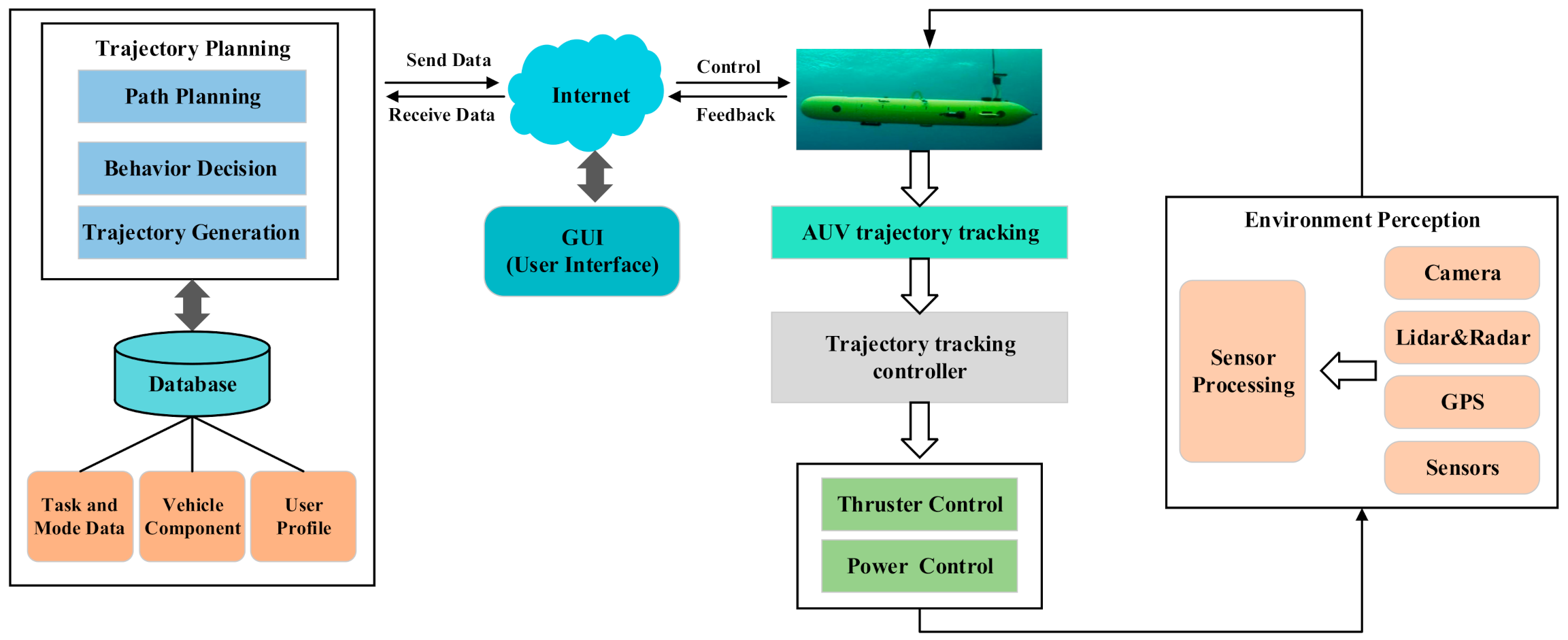
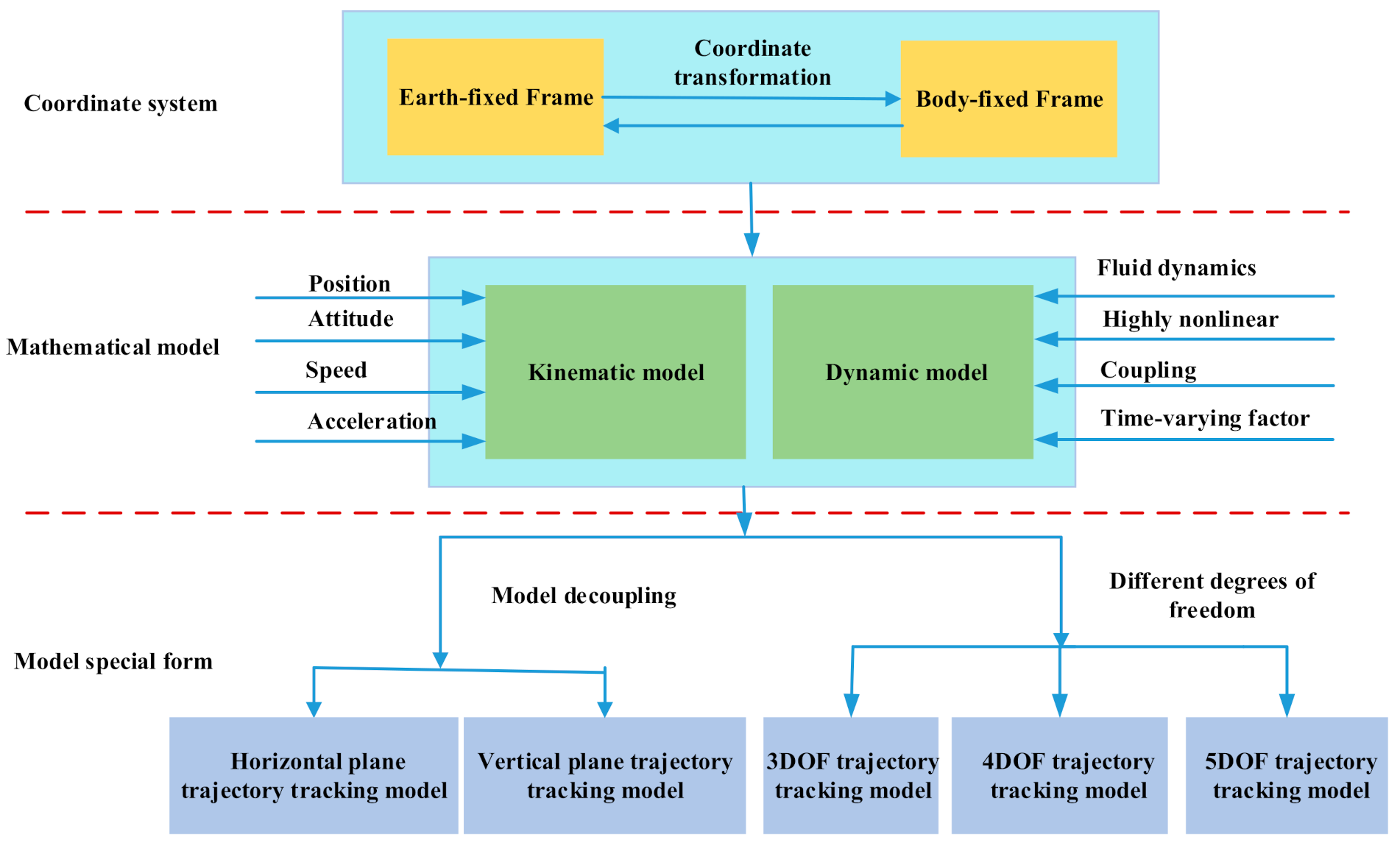
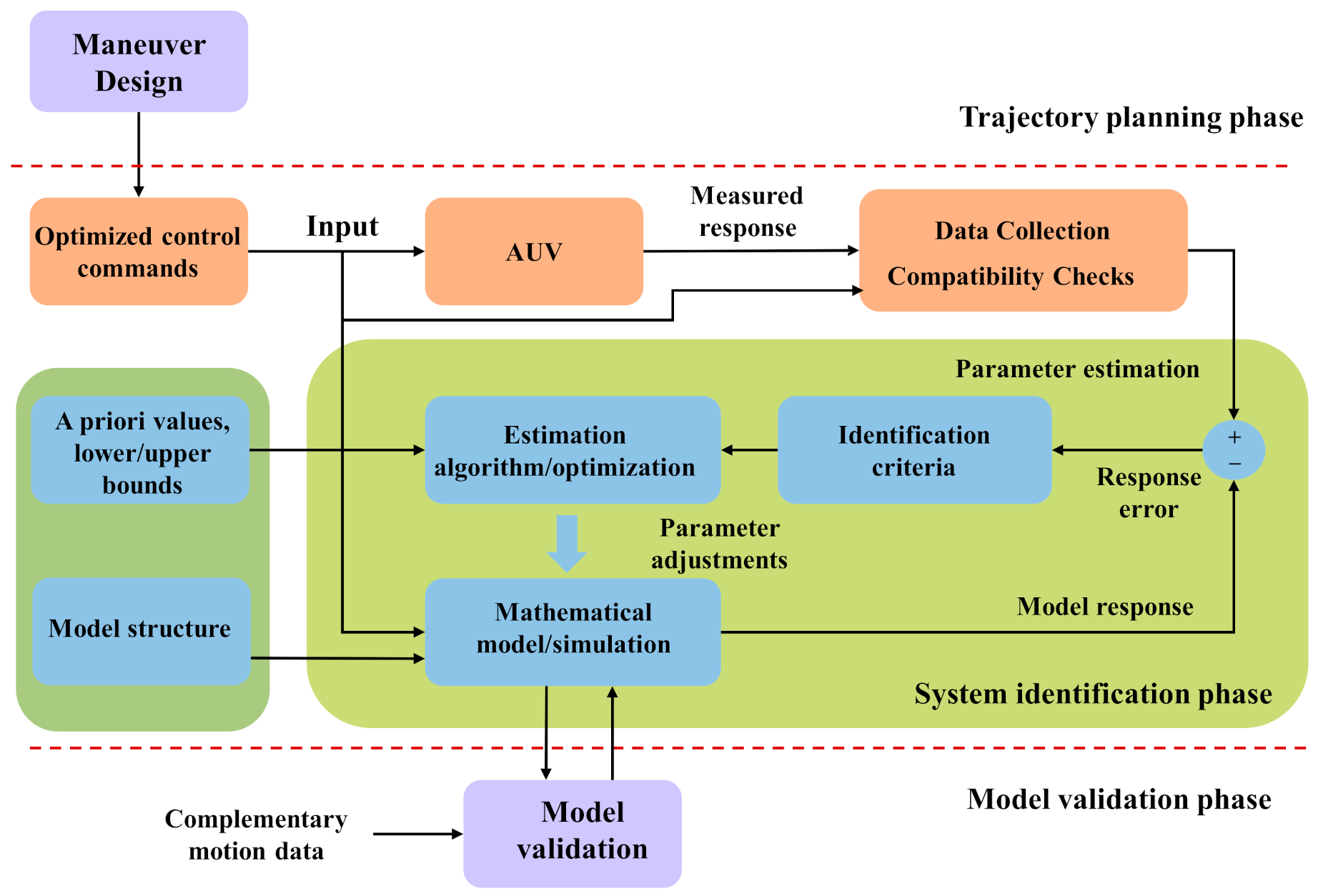
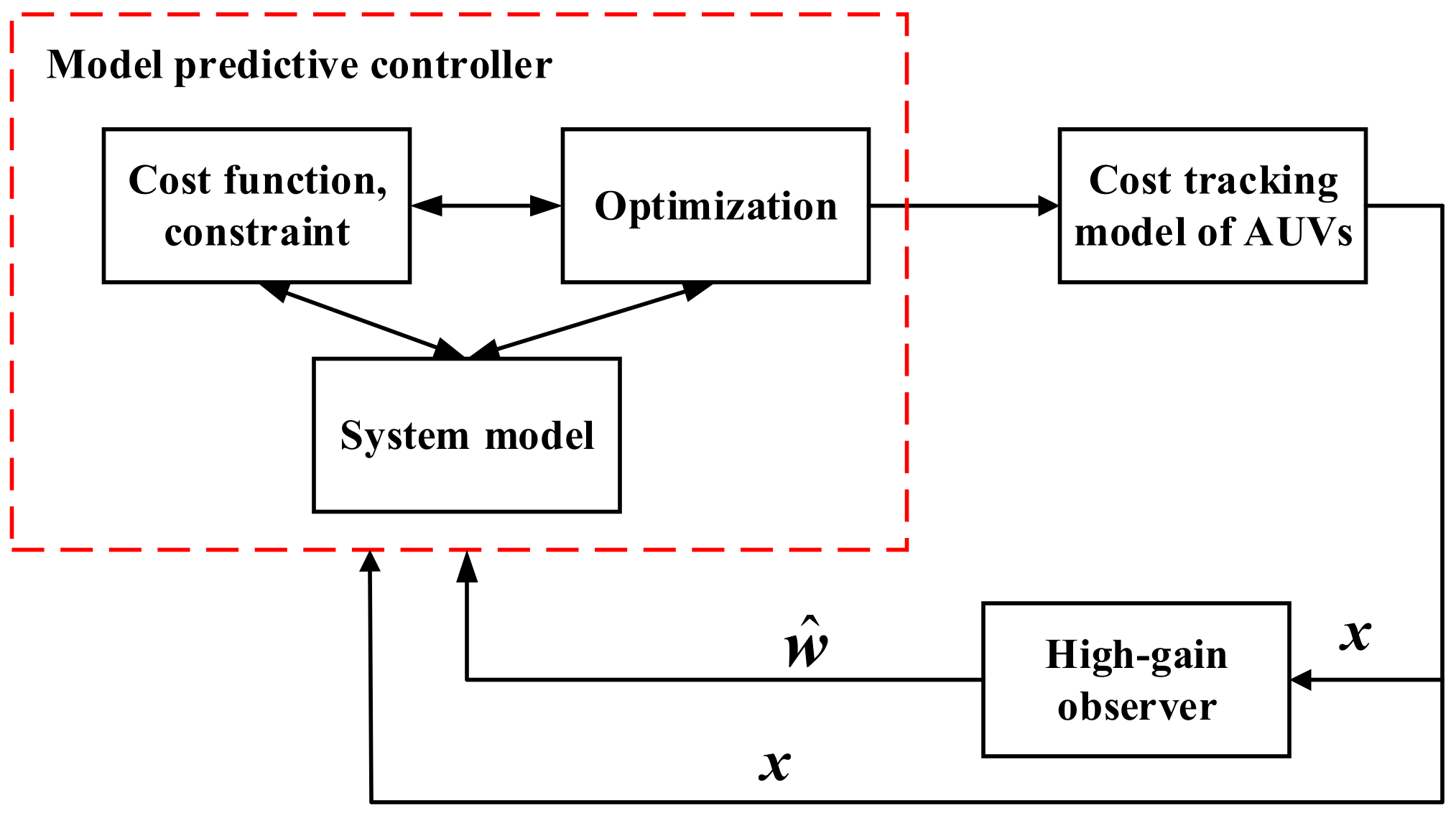
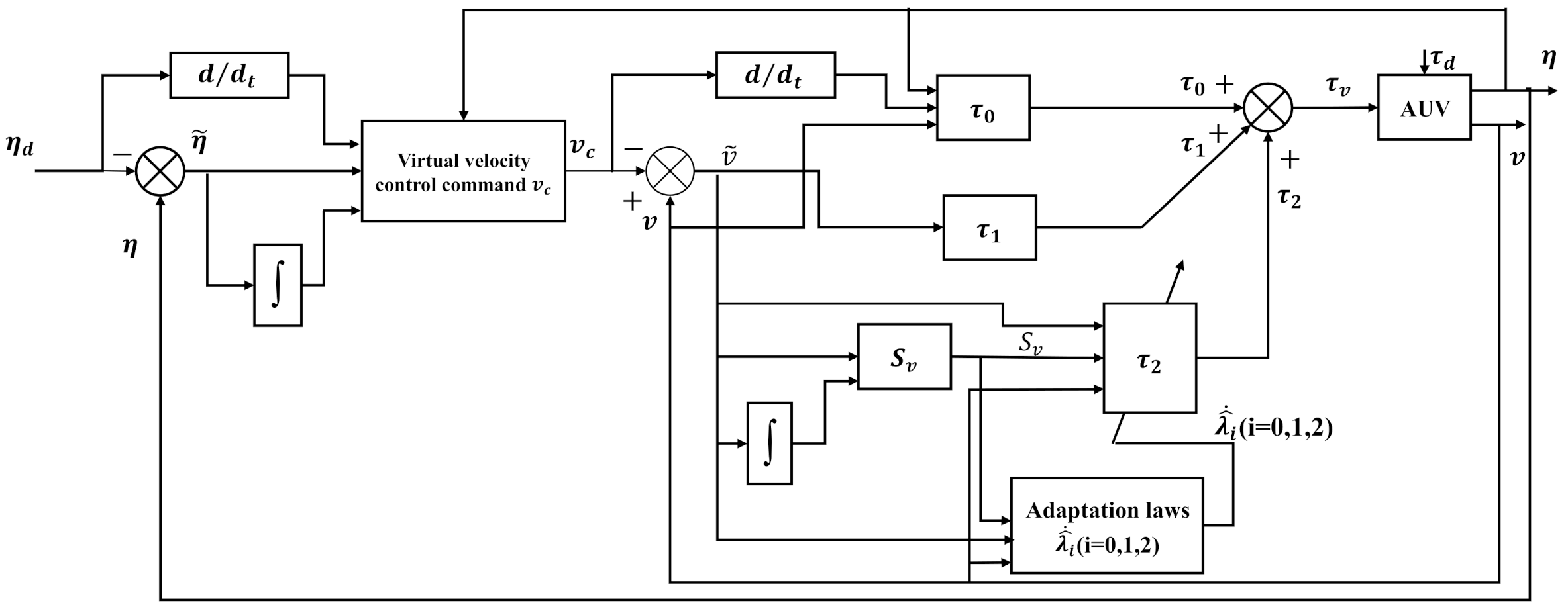
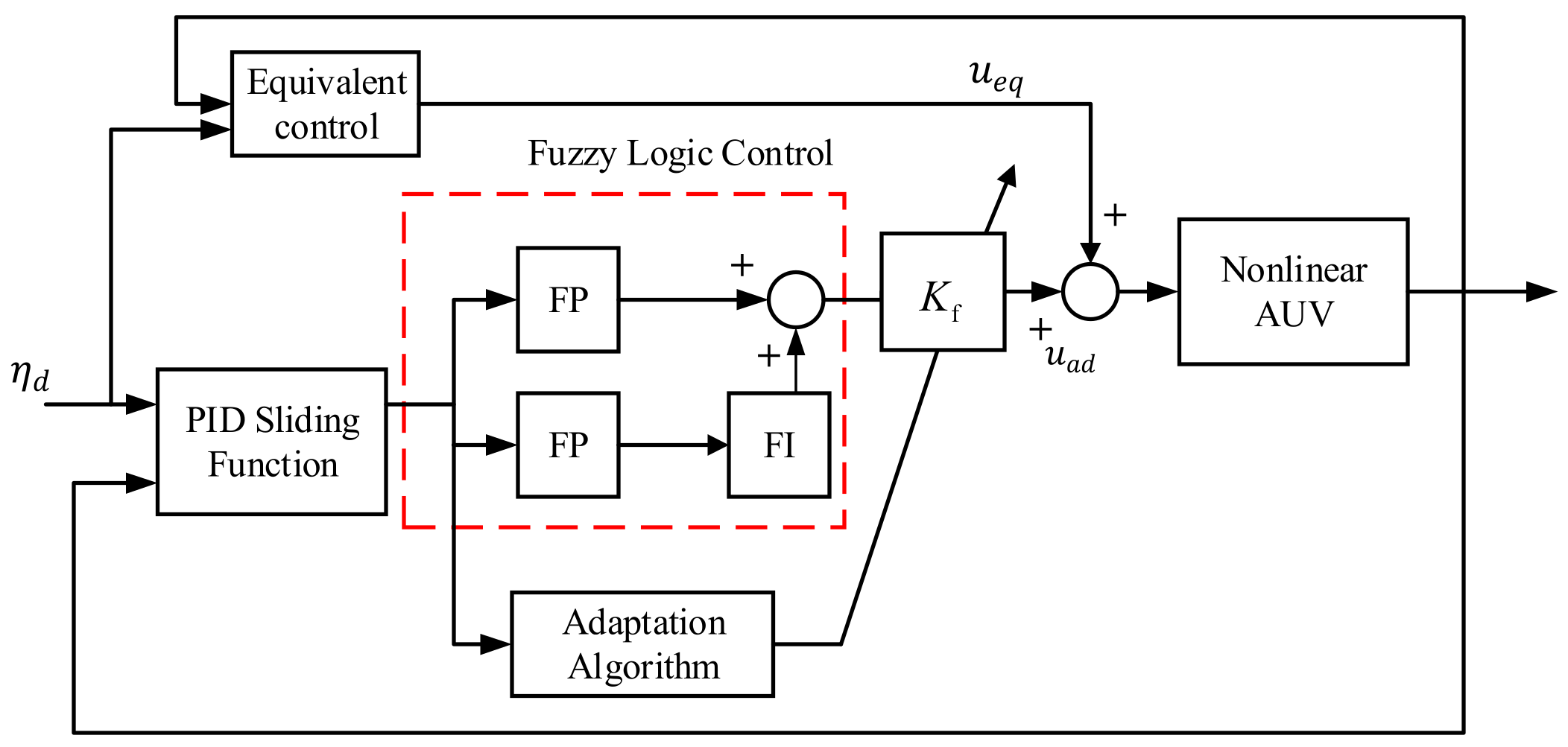
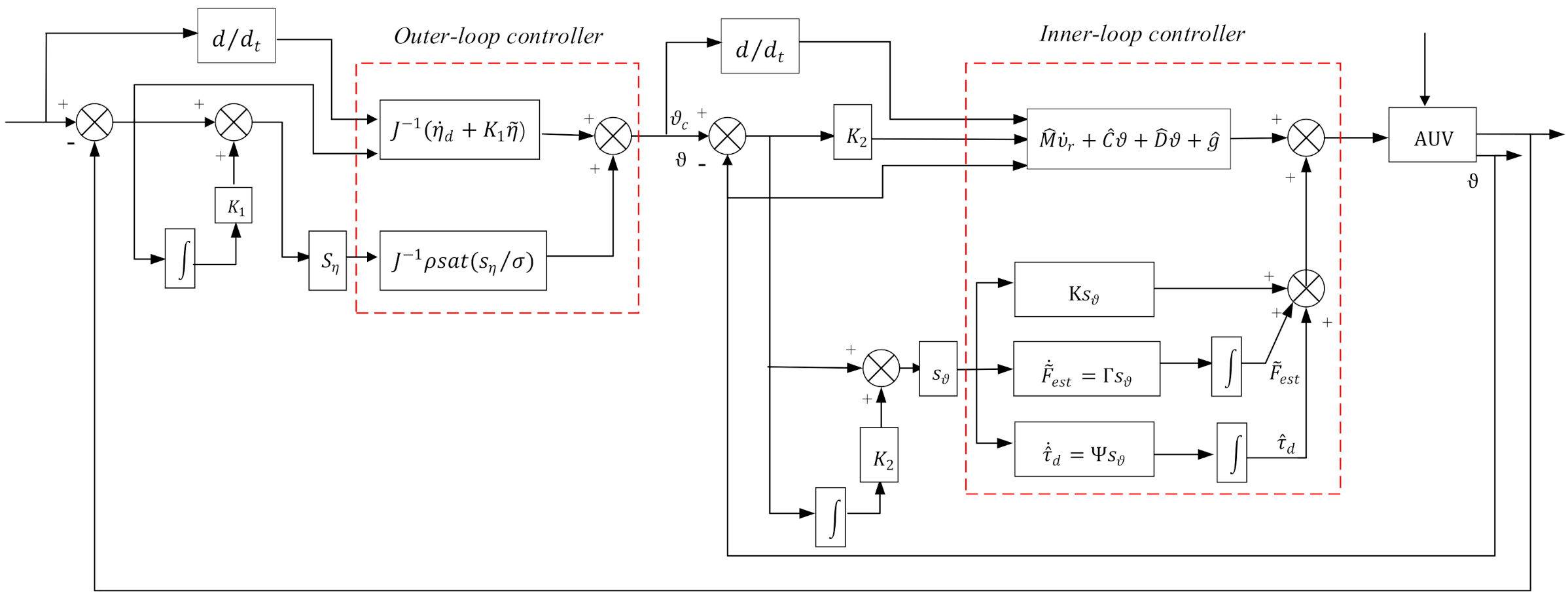

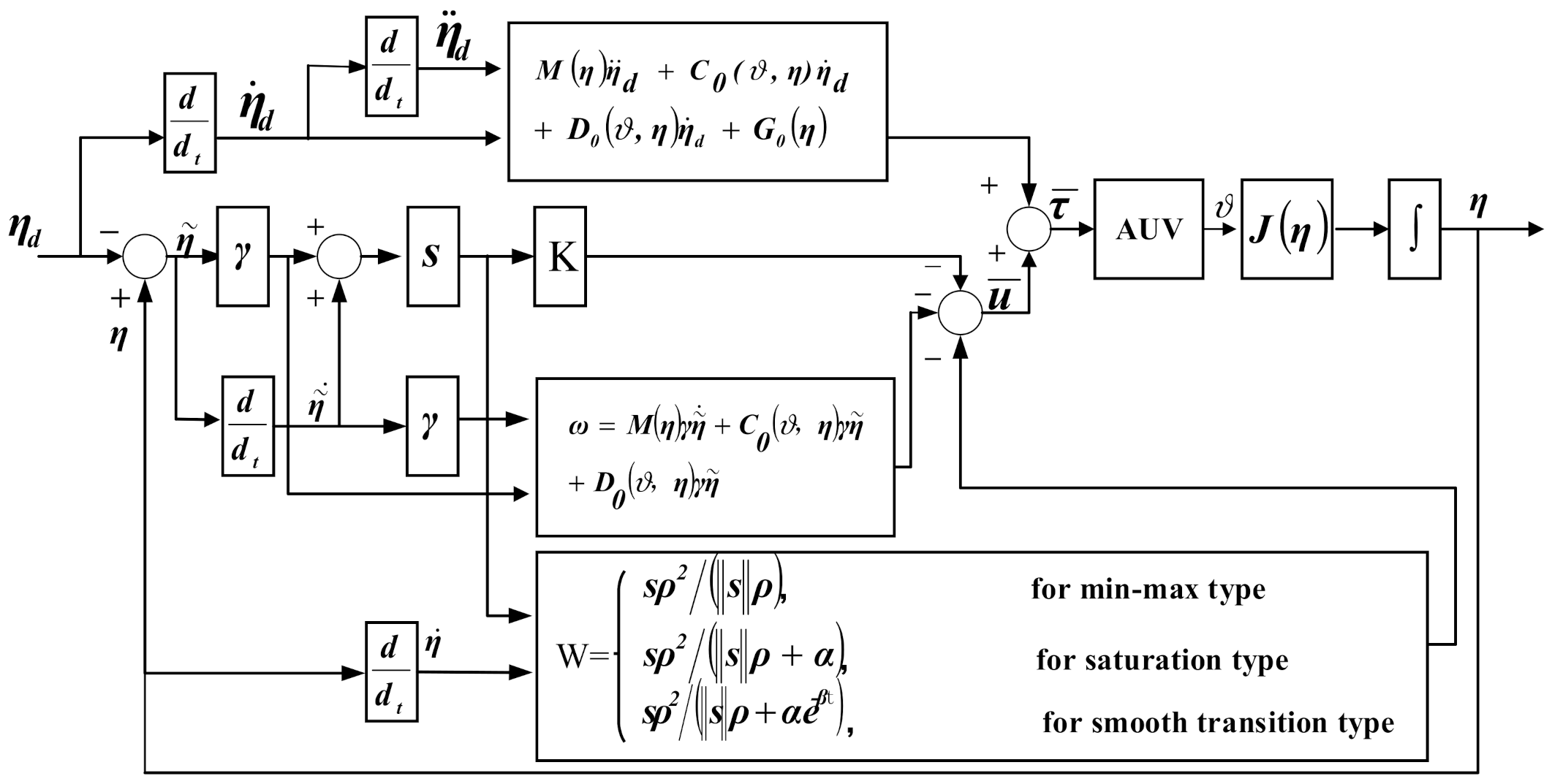
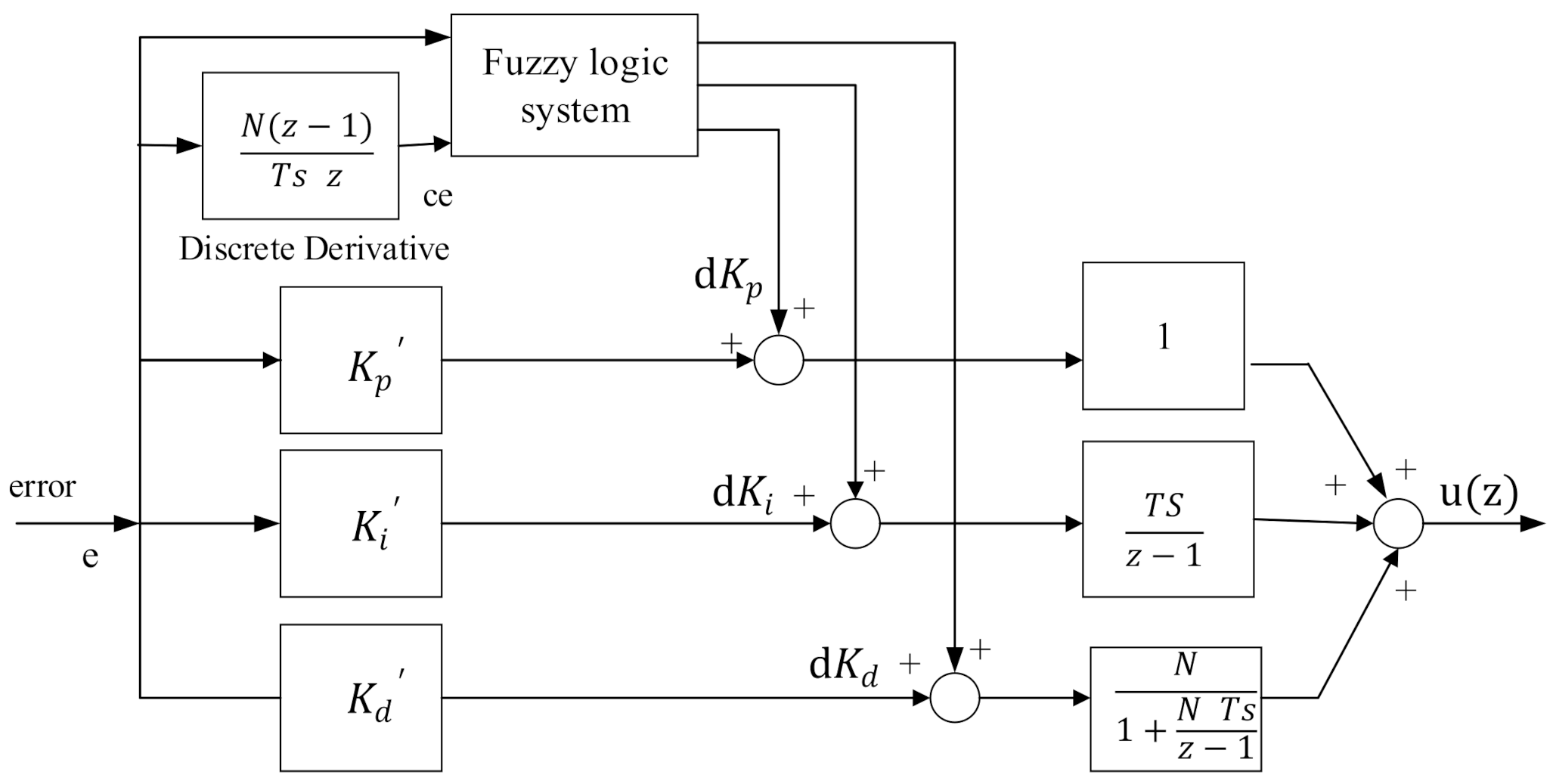
| Country | AUV Name | Research Institute | Working Depth (m) | Research Purpose |
|---|---|---|---|---|
| USA | REMUS-6000 | Woods Hole Oceanography Institute | 6000 | Offshore exploration, survey, and automatic sampling [4] |
| Odyssey | Massachusetts Institute of Technology | 3000 | Scientific investigation and ocean automatic sampling network research [5] | |
| CETUS | Massachusetts Institute of Technology | 4000 | Military torpedo detection search and danger elimination [6] | |
| SAUVIM | University of Hawaii | 6000 | Cable laying and demining | |
| China | CR-02 | Shenyang Automation Institute | 6000 | Mineral resources survey and development [7] |
| CR-01 | Shenyang Automation Institute | 6000 | Pacific Polymetallic Nodules Survey [8] | |
| “Explorer” | Shenyang Automation Institute | 4500 | Marine search and rescue, undersea resource survey [9] | |
| Germany | DeePC | STN Company | 4000 | The ice survey [10] |
| UK | AUTOSUB | Southampton Oceanographic Centre | 1600 | Multi-purpose marine survey and surveillance platform [11] |
| France | ALIVE | Cybernextix Company | 3000 | Equipment maintenance and investigation, archaeology and dangerous goods collection [12] |
| Portugal | Delfim | Dynamical systems and ocean roboticsLAB | 4000 | Collection and transmission of marine data [13] |
| Norway | HUGIN1000 | Konsberg | 1000 | Mine search mission [14] |
| HUGIN3000 | Konsberg | 3000 | Application of fuel cell to AUV [15] | |
| Japan | Tri-TON 2 | University of Tokyo, Japan | 2000 | Detect underwater mineral storage [16] |
| Canada | Theseus AUV | ISE research | 2000 | Ice cable laying [17] |
| Classification | Authors | Influencing Factors | Method of Modeling | Important Finding |
|---|---|---|---|---|
| Analytical model | [43] | The external environment disturbance and its coupling factors. | The Newton–Euler equation and the Quasi-Lagrange equation. | Not only reduces the number of model parameters, but also helps to analyze the impact of dynamic equations on the vehicle motion. |
| [46] | The external environment disturbance and its coupling factors. | Quasi-Lagrangian equation. | Divided the model into a series of interrelated subsystems. | |
| [47] | The external environment disturbance and its coupling factors. | Introduces additional items | Avoid nonlinear modeling errors. | |
| [51] | System coupling. | The optimization problem can be broken down into three smaller sub-problems. | This sub-problem should be solved in parallel so the calculation time can be greatly reduced. | |
| [77] | System coupling. | Ignore the coupling between the rolling surface motion and the two plane motions. | Shorten the calculation time required to determine each controller. | |
| [53] | System coupling. | Affine nonlinear systems. | Improved trajectory tracking accuracy | |
| [54] | Complexity and the nonlinearity of the model. | Linearizing an operating forward speed. | The high nonlinearity of the model is handled. | |
| [56] | Complexity and the nonlinearity of the model. | SDRE | Offer great design flexibility systematic and effective means for the design of control systems for nonlinear dynamical systems. | |
| [1] | Complexity and the nonlinearity of the model | local-CFDL | Avoid errors caused by the traditional linearization process. | |
| [57] | The significant interference caused by shallow water waves is introduced into the translational motion of the AUV. | A superposition of multiple regular blogs to implement the description of random waves. | Perform mathematical model of these disturbances to facilitate exercise planning and control purposes. | |
| System identification | [64] | N/A | least squares (LS) | Offline system identification method. |
| [69] | Measurement noise and mild nonlinearity. | Observer Kalman filter. | Remove noise and nonlinearity to make the model more accurate. | |
| [42] | The AUV system is influenced by nonlinear factors and require nonlinear filtering methods. | Extended Kalman filter (EKF). | Use the instantaneous linearization of each time step to approximate nonlinearity. | |
| [73] | The external environment disturbance and its coupling factors. | NN approximator and adaptive technology. | Estimate the uncertainty of the model due to unknown vehicle parameters, unmodeled dynamics, and constant or time-varying disturbances caused by waves and ocean currents. |
| Control Strategy | Classification | Improvement | Control Object | Control Effect | Ref. |
|---|---|---|---|---|---|
| LQR | LQR | — | Track the reference trajectory. | Accurate tracking of spiral, sawtooth paths and 3D Dubin paths. | [80] |
| SDRE | SDRE | A hyperbolic tangent sigmoid function is introduced to equivalently replace the rudder angle variable. | Achieve the rudder saturation constraint problem. | The error of the trajectory tracking to converge smoothly to the steady state value. | [56] |
| The quadratic performance index. | Deal with suboptimal underwater surface control problems in AUV. | Depth control is achieved with actuator saturation and parameter uncertainty. | [83] | ||
| MPC | MPC | Genetic algorithm. | Track the reference trajectory. | Track the given nonlinear path with satisfactory accuracy. | [87] |
| Recurrent neural network. | Control of AUVs in a vertical plane. | Track the given nonlinear path with satisfactory accuracy. | [88] | ||
| LMPC | C/GMRES algorithm. | Handling the actual constraints of the AUV thruster. | Improve the algorithmic efficiency of the NMPC algorithm. | [85] | |
| DMPC | Subproblems and the warm start strategy. | Solve AUV control problems to track time-varying trajectories. | Reduce controller runtime and achieve good control. | [51] |
| Control Algorithm | Research Purposes | Improvement | Control Effect | Ref. |
|---|---|---|---|---|
| Sliding mode control | Improve control accuracy | Robust sliding mode controller | Successfully controls the AUV roll angle, pitch angle and yaw angle within 10 s. | [106] |
| Sliding mode variable structure control | The AUV can accurately reach the termination point from the starting point. | [107] | ||
| Fuzzy logic | The trajectory tracking accuracy of the vehicle in all directions is very high. | [46] | ||
| Solve the jitter problem | Bounded adaptive estimation | Solve the problem of speed jump due to initial error in conventional backstepping method, avoiding thruster saturation and satisfying control input and speed constraint conditions. | [96] | |
| Dual closed-loop adaptive integral sliding mode controller | The designed controller can effectively eliminate the flutter effect. | [97] | ||
| Self-adaptive fuzzy PI sliding mode control | PISMC has less oscillator response and the shortest delay time. | [95] | ||
| Adaptive fuzzy sliding mode with PID sliding surface | Avoid response oscillating and reduce arrival time. | [94] | ||
| Achieve the finite-time convergence of the system dynamics | The terminal sliding mode | Force the AUV’s position to track the desired time-varying trajectory. | [54] | |
| Adaptive nonsingular integral terminal sliding mode control | Better robustness and faster convergence. | [91] | ||
| Solve the limitations of actuators | The second-order sliding mode controlled | Effectively compensate for the uncertainties of the hydrodynamic and hydrostatic parameters of the vehicle and can eliminate unpredictable disturbance effects. | [108] | |
| A second-order sliding mode controller using PID sliding surface | 2-SMC with switching controller showed smaller rms error in steady state than 2-SMC without switching controller. | [98] | ||
| Realize horizontal trajectory tracking | Line-of-sight method | The underwater vehicle can be accurately set according to the preset, except for deviations at the starting point and the turning point. | [109] | |
| Combination of the lateral trajectory error method and the line-of-sight method | Guarantees global κ-exponential stability of the cross-track error to straight line trajectories in three-dimensional space. | [110] | ||
| Combining the cross-tracking error method and the line-of-sight method | The sliding mode controller has good tracking performance for time-varying depth signals. | [111] | ||
| Backstepping control | Estimate faster convergence of parameters and tracking errors | Adaptive control scheme | Realize three-dimensional track precise tracking control. | [104,112] |
| AUV’s virtual speed control and trajectory tracking enable asymptotic stability | Hierarchical control | The robustness of the system under environmental disturbance is guaranteed. | [105,113] |
| Control Algorithm | Classification | Improvement | Control Object | Control Effect | Ref. |
|---|---|---|---|---|---|
| Fuzzy control | Fuzzy PID | Self-tuning nonlinear fuzzy PID controller | Control position and speed to follow desired trajectories. | Compared with traditional PID, the response speed is faster and the minimum error time is reduced. | [119] |
| Hierarchical closed-loop fuzzy control | Closed loop planar trajectory tracking. | Motion and velocity errors are bounded and fast converging, showing the robustness of the control algorithm for external disturbances. | [121] | ||
| Direct adaptive control | Compensate for the effect of actuator saturation. | System stability for trajectory tracking in the presence of actuator saturation. | [20] | ||
| Neural network control | Adaptive neural network | Unscented Kalman filter | Pose estimation. | Ensure the accuracy and certainty of the estimate, as well as the feasibility of trajectory tracking control. | [125] |
| Filtered technique | Trajectory tracking of AUV with model errors and external disturbances. | Avoided “explosion of complexity”. | [126] | ||
| Linearly parameterized radial basis function | Estimate unknown terms. | Removing the inherent error. | [123,127] | ||
| Nonlinear adaptive controller | Precise trajectory tracking. | A satisfactory approximation capacity and clearly result in superior tracking performance. | [74] | ||
| Online neural network controller | Dynamic linear compensator | Compensating model error. | Extend the operating range of the AUV beyond the capacity of the linear controller. | [128] | |
| Reinforcement learning | Address unknown disturbances, parameter uncertainties and control input nonlinearities. | Obtain the optimal tracking performance. | [124,136] | ||
| Hybrid control | Dynamic surface control | Tracking curve or straight line. | Reduces controller complexity. | [37,47] | |
| Reinforcement learning | Reinforcement learning | Designed the reward function | Precise trajectory tracking. | The thrusters were 11.14% less solicited by the latter controller. | [132] |
| Deep reinforcement learning | A reward function for deep RL | Improve AUV trajectory tracking precise. | Effectively improve reliability and stability, reduce energy consumption, and restrain the vectored thruster sudden change. | [133] | |
| Interactive reinforcement learning | Learns from both human rewards and environmental rewards at the same time | Improve rewards and learning efficiency. | AUV can converge faster than a DQN learner from only environmental reward. | [134] | |
| Model-free goal-driven deep RL | Based on the DDPG algorithm | Self-tuning of the low-level PID controllers of mobile robots. | Improved adaptability, making the agent able to adapt to different operative conditions | [135] |
| Control Types | Strength | Weakness | Future Improvement | Whether Based on Model |
|---|---|---|---|---|
| PID | Flexibility, simplicity, and good performance. | Poor resistance to external interference. | Developed by combining other control algorithms. | Y |
| LQR | Can set the unstable system, and the method is simple and easy to implement. | Lacks the characteristics of robustness. | Online iterative learning linear quadratic regulator (OILLQR). | Y |
| SDRE | Ensure a wide range of progressive stability | Only applicable to the affine nonlinear system in the form of state correlation coefficient (SDC). Can only guarantee the local asymptotic stability of the closed-loop system. | Each mathematical model of each cycle can be processed into a form similar to a linear system, and the feedforward method is used to compensate for the nonlinear redundancy terms. | Y |
| MPC | Effectively overcome the uncertainty of controlled objects, the dynamic effects of lag and time-varying factors. | Heavy online computational burden. | Offline precomputation, delay compensation, event triggering strategies, and digital continuations. | Y |
| SMC | Has a certain resistance to modeling errors, time-varying parameters, and external environment interference. | Jitter problem. | The filtering or fuzzy sliding mode control method. | Y |
| Backstepping control | The actuator’s control output is continuous and the control system does not experience jitter. | Vehicle tracking speed jump problem.Inherent disadvantage of “explosion of complexity”. | The “dynamic surface control” technique. | N |
| Adaptive control | Ability to re-adjust controller parameters online | Asymptotic convergence under ideal conditions of time infinity. | Combined with other control methods. | N |
| Robustness control | Ensure a certain level of dynamic performance while maintaining stability. | Cannot counter the complex control system in actual engineering | The combination of different methods can make the control scheme more effective. | Y |
| Fuzzy Control | The control system can maintain good performance even when the characteristics of the controlled object change or perturb. | When establishing methods of fuzzification and inverse fuzzification, there is a lack of systematic methods. | The neural network can dynamically adjust the membership function and the fuzzy rule according to the system information. | N |
| NN | Greater degree of fault tolerance and strong data processing capabilities. | Exists a limitation referred to as “the curse of dimensionality”. | Use the “Minimum Learning Parameter (MLP)” algorithm to reduce the computational burden of the algorithm. | N |
| Cascaded system | Simplifying the controller design, the expression control law is not complicated. | _ | _ | N |
| Bio-inspired | Eliminate the speed jump problem. | _ | _ | Y |
Publisher’s Note: MDPI stays neutral with regard to jurisdictional claims in published maps and institutional affiliations. |
© 2021 by the authors. Licensee MDPI, Basel, Switzerland. This article is an open access article distributed under the terms and conditions of the Creative Commons Attribution (CC BY) license (https://creativecommons.org/licenses/by/4.0/).
Share and Cite
Li, D.; Du, L. AUV Trajectory Tracking Models and Control Strategies: A Review. J. Mar. Sci. Eng. 2021, 9, 1020. https://doi.org/10.3390/jmse9091020
Li D, Du L. AUV Trajectory Tracking Models and Control Strategies: A Review. Journal of Marine Science and Engineering. 2021; 9(9):1020. https://doi.org/10.3390/jmse9091020
Chicago/Turabian StyleLi, Daoliang, and Ling Du. 2021. "AUV Trajectory Tracking Models and Control Strategies: A Review" Journal of Marine Science and Engineering 9, no. 9: 1020. https://doi.org/10.3390/jmse9091020
APA StyleLi, D., & Du, L. (2021). AUV Trajectory Tracking Models and Control Strategies: A Review. Journal of Marine Science and Engineering, 9(9), 1020. https://doi.org/10.3390/jmse9091020







